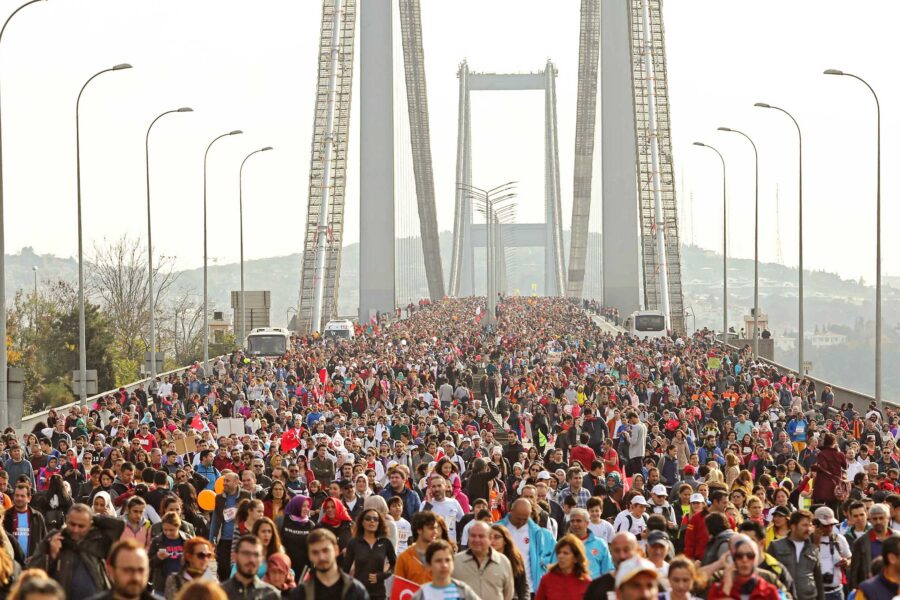Tackling online violence against women
Digital platforms offer powerful spaces for female voices. But online violence and abuse against women have also grown massively, and will only worsen without urgent action
Gender — Global

Digital platforms, particularly social networks, have been central to the widespread global growth of feminism. Movements such as “Ni Una Menos” in Argentina in 2015, with its repercussions throughout Latin America and the Caribbean, and, two years later, “Me Too” in the United States, generating enormous global resonance, highlight the importance of the virtual world for activists and activism.
Women’s and diversity movements have grown in number and, notably, provoked cultural changes that continue to this day. This growth can also be attributed to feminist activist voices – particularly communicators and defenders of human rights – who have gained ground in the digital world and within social networks. Their participation has opened up conversations on distinct issues about the gender and human rights agenda. It has also been accompanied by great advances in public policy, and by detaining attempts to push back against such progress.
However, these advances in the public participation of women has also unleashed, in the last five years, a brutal reaction, especially against communicators and defenders of human rights and female politicians. Online gender abuse has grown exponentially and the modes in which it manifests itself have multiplied. These include:
- cyber bullying
- identity theft and impersonation
- publication of personal data
- smear campaigns
- defamation or discrediting
- online extortion
- legal threats
- massive coordinated attacks with xenophobic, racist, and sexist comments, on occasions with the proven participation of relevant figures within the three legislative powers of the state
Currently, women involved in advocacy and forming public opinion suffer persistent attacks. These have a negative impact on freedom of speech and participation in public debate, and consequently on the very quality of democracy. Online gender-based abuse aims to silence voices, discipline, lecture, and instill fear. This has both personal and wider social consequences, as those attacked retreat from the conversation and public debate.
Digital platforms are, for all these women, the forum of expression and diffusion of their professional activity. But this terrain, where women activists have created their public voice, individually and collectively, is also where they are systematically hounded.
A recent qualitative study in Latin America and the Caribbean reveals disturbing patterns of online gender abuse toward women with a public voice and its impact on freedom of expression. The report, published by UN Women and the Regional Alliance for Freedom of Expression, shows that while there may be differences in the degrees of abuse, a common denominator emerges: while threats may take place in the virtual world (although all too often moving offline), the effects are real. In every case they affect liberty of expression and freedom of speech.
Another report, Cyberviolence and cyberharassment against women and girls by UN Women and the Follow-up Mechanism of the Belém do Pará Convention (MESECVI), defines online abuse as:
“…whatever action or conduct against women, based on their gender, that causes death, damage, or physical suffering, sexual or psychological, economic or symbolic, in whatever ambit of their life, and which is committed, instigated, or aggravated in part or completely with the aid of information and communication technology.”
In this sense, to talk of online violence or abuse as something alien, separate, and distanced from structural gender violence or abuse is a mistake, and plays down its importance.
This is also supported by a UNESCO discussion paper, The Chilling: Global trends in online violence against women journalists. The paper concludes that online violence or abuse is “spilling into the offline world in an accelerating manner, at times with devastating consequences.” In her report on combating violence against women journalists, the then UN Special Rapporteur on violence against women and girls, Dubravka Šimonović, also uses “chilling” to describe the manner in which cyberbullying does not always remain in the digital sphere. She warns how this type of gender violence forms part of the daily routine for women working in communications media, particularly those writing on “feminist issues.”
Irene Khan, UN Special Rapporteur for freedom of opinion and expression, highlights in the introduction to a collection of essays on personal experiences of bullying that communicators are attacked because “they dare to raise their voices,” and speaks of “the censoring of gender.” So, it is clear that female communicators, politicians, and defenders of human rights are attacked for their condition of being women with a public voice.
The UNESCO paper also highlights that there is evidence of coordinated attacks against female journalists and of the participation of politicians and leaders in generating, instigating, or at the very least promoting and encouraging them. Online violence is now a global problem, albeit with particular characteristics in individual regions and countries. The differences of severity from place to place are marked by factors such as:
- the geopolitical situation
- the participation of political leaders and government officials in the attacks
- the role that the state assumes
- the network of support that victims can rely on
- the extent of offline violence stemming from the online world
The most common consequences of online violence are withdrawal from the field and self-censoring.
So far, this is a bleak diagnosis of the situation. The questions that arise are:
- how do we reduce online violence or abuse for reasons of gender?
- how do we protect those that systematically suffer from it?
The first step is to make it visible. During the previous century, and through a great part of the current one, individual states, international organisations, and civil society have developed mechanisms against the normalization of, prevention against, and response to more traditional gender violence. Now is the time to address digital gender violence, to raise awareness of its existence, and to evaluate the tools with which to prevent it as well as to diminish its impact. As in all cases, it requires an integrated approach that involves diverse actors with distinct levels of responsibility.
The MESECVI and UN Women warn that “states are obliged to take effective measures to raise awareness about online gender violence.” They also point out the “problematic behavior” of corporations, and the opacity with which online platforms manage content moderation and the functioning of their algorithms. Nations and corporations have a responsibility to protect the defenders of human rights, educate and raise awareness on online violence, and promote respectful, peaceful public debate.





